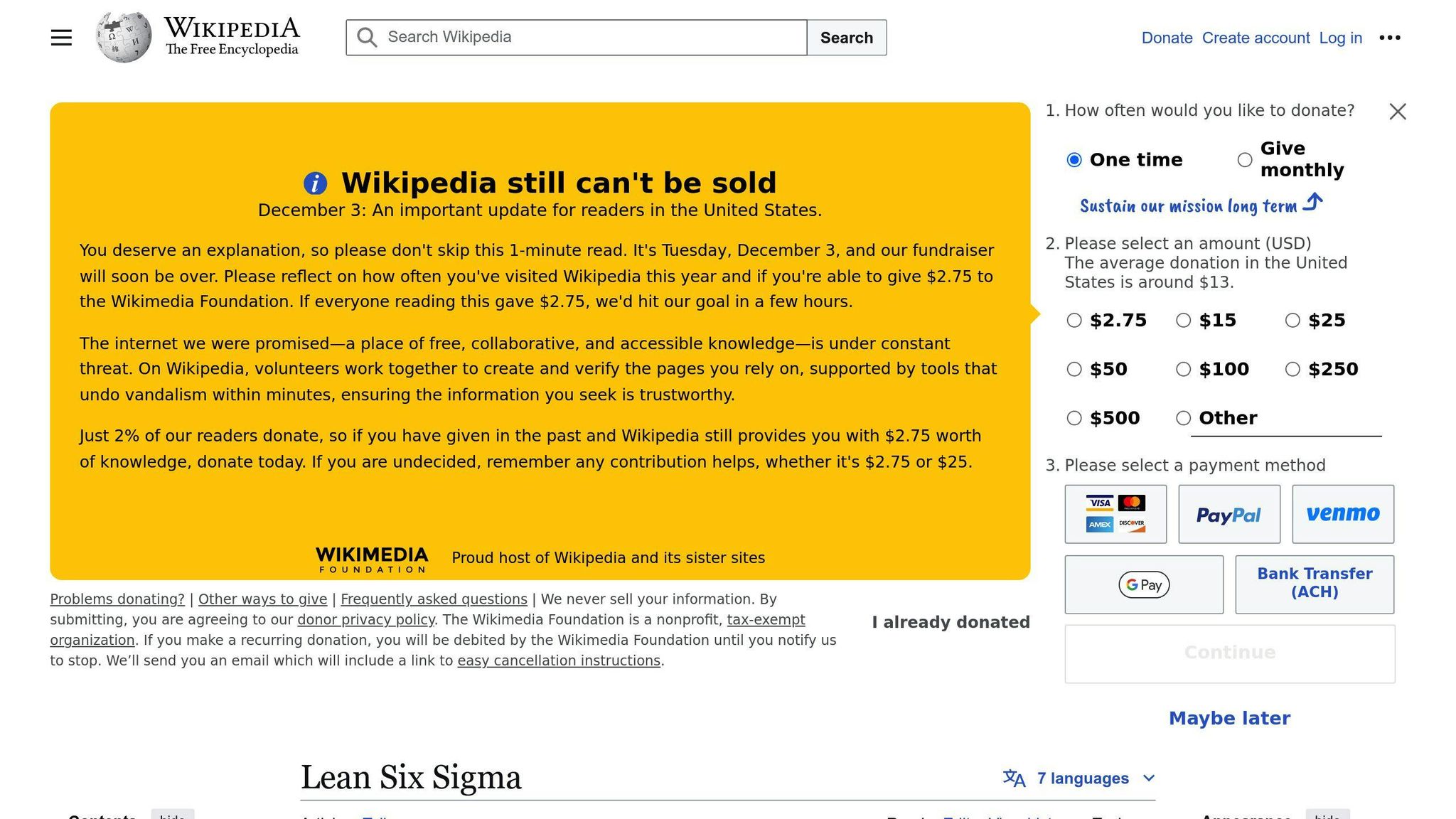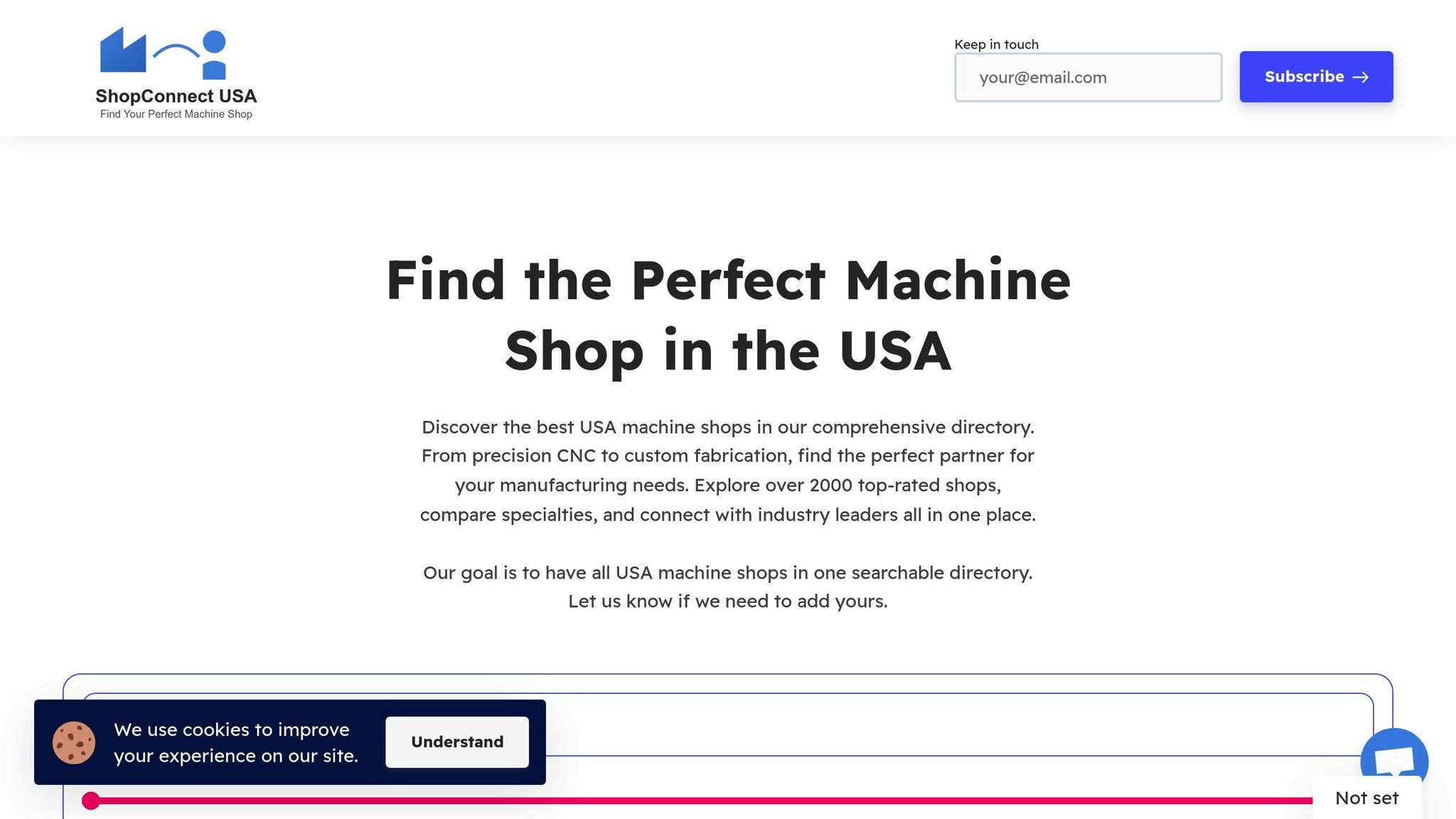Fishbone Diagram: Root Cause Analysis Guide
A Fishbone Diagram, also called an Ishikawa or Cause-and-Effect Diagram, is a simple tool to identify the root causes of problems. It's widely used in manufacturing and quality control to break down complex issues into manageable parts. Here's a quick overview:
- Purpose: Identify and organize potential causes of a problem.
- Structure: Looks like a fish skeleton, with the problem at the "head" and causes branching out as "bones."
- Categories: Common categories include Machines, Methods, Materials, People, Environment, and Measurement.
Why Use It?
- Helps pinpoint root causes instead of symptoms.
- Encourages teamwork and cross-functional collaboration.
- Fits seamlessly into Lean Six Sigma's Analyze phase.
How to Create One:
- Define the Problem: Be specific and measurable.
- Identify Categories: Use standard categories or customize them.
- Brainstorm Causes: Ask "Why?" repeatedly to dig deeper.
- Prioritize Causes: Use data to focus on the most impactful ones.
By combining Fishbone Diagrams with tools like the Machine Shop Directory, you can move from analysis to actionable solutions, improving manufacturing processes effectively.
Fishbone Diagram EXPLAINED - Root Cause Analysis Techniques
Steps to Create a Fishbone Diagram
Creating a Fishbone Diagram involves a step-by-step process to pinpoint and analyze root causes in manufacturing issues. Here's how you can approach it effectively.
Step 1: Define the Problem Clearly
Start by writing a clear, measurable problem statement at the "head" of the fish. Be specific - replace vague terms like "quality issues" with something like "10% rise in CNC machining defects in Q3 2024." Stick to measurable facts, avoid assigning blame, and make sure the statement is easy for everyone to understand.
Step 2: Identify Key Cause Categories
Draw the main "bones" branching out from the central spine. Each bone represents a primary category of causes. Common categories include:
- Machines: Equipment condition, calibration
- Methods: Workflows, standardization
- Materials: Supplier quality, specifications
- People: Training, supervision
- Environment: Workspace conditions
- Measurement: Inspection methods
These categories help organize potential root causes.
Step 3: List Possible Causes
Work with your team to brainstorm causes under each category. To dig deeper, use the "5 Whys" technique. For example, if a machine is producing defects, ask "Why?" repeatedly (e.g., calibration issues, missed maintenance schedules) until you uncover the root cause.
Step 4: Evaluate and Prioritize Causes
Back your analysis with data and focus on causes that meet these criteria:
- Strong evidence shows their impact
- They can be addressed with current resources
- They offer long-term solutions
- They align with broader quality improvement goals
This approach mirrors Lean Six Sigma principles, emphasizing data-based decisions and lasting improvements.
Advantages of Fishbone Diagrams in Manufacturing
This method aligns perfectly with Lean Six Sigma principles, focusing on cutting waste and improving manufacturing processes.
Organized Problem-Solving
Fishbone Diagrams help manufacturing teams break down problems step-by-step, making it easier to see how different factors are connected. They provide a clear way to:
- Analyze causes across categories like machines, methods, and materials.
- Spot relationships between various factors.
- Identify and prioritize areas for improvement.
This clear structure not only simplifies problem-solving but also sets the stage for effective teamwork.
Improved Team Collaboration
The visual format of Fishbone Diagrams encourages collaboration between departments, allowing people with different expertise to contribute.
"The fishbone diagram is a powerful tool for conducting root cause analysis, enabling teams to delve deep into the underlying causes of a problem while fostering teamwork and leading to innovative and effective solutions." - Dr. Kaoru Ishikawa, renowned Japanese quality management expert.
Some key benefits of this collaboration include:
| Benefit | Impact on Manufacturing |
|---|---|
| Cross-functional Input | Teams from various departments bring unique perspectives. |
| Shared Insights | Teams align on causes and share solutions across departments. |
By pooling knowledge from different areas, teams can zero in on the actual root causes of manufacturing issues.
Targeting Root Causes Over Symptoms
Fishbone Diagrams are particularly effective at digging beneath surface problems to find their true sources. This allows manufacturing teams to:
- Separate symptoms from the real causes.
- Understand how different factors are interconnected.
- Create meaningful solutions.
- Implement changes that last.
sbb-itb-b5aecec
Using Fishbone Diagrams in Lean Six Sigma

Role in Lean Six Sigma
Fishbone Diagrams play a key role in the Analyze phase of the DMAIC (Define, Measure, Analyze, Improve, Control) methodology. They help teams break down and organize potential causes of defects into categories like Methods, Machines, People, Materials, Measurement, and Environment.
| Category | Focus Areas |
|---|---|
| Methods | Production processes and procedures |
| Machines | Equipment and technology issues |
| People | Training, skills, and human factors |
| Materials | Raw materials and components |
| Measurement | Testing and quality control |
| Environment | Workplace conditions and external factors |
When combined with other Lean Six Sigma tools, these diagrams allow for more targeted and effective solutions. This method is not just theoretical - it’s widely used in real-world manufacturing to address complex issues.
Examples in Manufacturing
Take the example of a precision manufacturing facility that used a Fishbone Diagram to tackle iron contamination. Their analysis pinpointed aging machine parts, calibration errors, and airborne particles as the main problems. By replacing outdated components, improving testing protocols, and installing air filtration systems, the facility achieved a 65% reduction in contamination. This shows how Fishbone Diagrams, integrated into Lean Six Sigma practices, can identify root causes and lead to impactful changes.
Finding Solutions with the Machine Shop Directory

How the Machine Shop Directory Helps
The Machine Shop Directory serves as a bridge between Fishbone Diagram analysis and actionable solutions, linking manufacturers with the right partners to tackle issues identified during root cause analysis. After pinpointing problems in the Analyze phase, the directory supports the Improve phase of DMAIC by connecting users with manufacturing experts who can implement precise solutions.
Here's how the directory addresses common issues highlighted in Fishbone Diagrams:
| Problem Category | Solution Provided by the Directory |
|---|---|
| Equipment Issues | Access to shops with advanced CNC machinery |
| Material Quality | Specialists in high-grade material processing |
| Process Inefficiencies | Expertise in custom fabrication |
| Quality Control | Precision-focused manufacturing capabilities |
Connecting with Top Machine Shops
When a Fishbone Diagram uncovers manufacturing problems, the Machine Shop Directory simplifies the process of finding qualified partners. Users can search and filter shops by their expertise, equipment, and quality certifications, ensuring they connect with the right match for their specific challenges.
Conclusion
Summary of Key Points
Fishbone Diagrams have been a key tool in manufacturing quality control since Kaoru Ishikawa introduced them in the 1960s. They offer a structured way to pinpoint and address inefficiencies, fitting seamlessly into Lean Six Sigma practices. Their real strength? Helping teams focus on uncovering root causes instead of just addressing symptoms.
By integrating Fishbone Diagrams with Lean Six Sigma, industries have transformed their quality improvement processes. These diagrams break down complex problems into clear categories, making it easier for teams to analyze deeply and create effective solutions. This combination of systematic analysis and actionable insights has made Fishbone Diagrams a staple in modern manufacturing.
Final Thoughts on Fishbone Diagrams
Fishbone Diagrams are most effective when used alongside other tools and resources. Once root causes are identified, resources like the Machine Shop Directory can help turn analysis into real-world results. Combining this visual method with techniques like the 5 Whys creates a solid framework for tackling core issues.
Manufacturing success depends on blending analytical tools like Fishbone Diagrams with practical solutions. Tools such as the Machine Shop Directory help bridge the gap, offering access to over 200 specialized shops that can implement the precise solutions identified through Fishbone analysis.
Here’s how to balance analysis and implementation effectively:
| Analysis Phase | Implementation Phase |
|---|---|
| Use Fishbone Diagrams to systematically identify problems | Partner with specialized machine shops for precise solutions |
| Apply root cause analysis methods | Execute targeted manufacturing improvements |
| Foster team collaboration | Work with expert manufacturing partners |
| Document findings and patterns | Monitor progress and measure outcomes |
This balanced approach ensures that manufacturing problem-solving remains both thorough and actionable.
FAQs
How do you do a fishbone root cause analysis?
Conducting a fishbone root cause analysis involves a clear, step-by-step process that manufacturing teams can follow. Here's how it works:
| Step | Action | Key Consideration |
|---|---|---|
| Problem Definition | Write the problem statement at the diagram's head | Be clear and specific |
| Category Selection | Choose relevant categories | Tailor categories to your situation |
| Cause Identification | List potential causes under each category | Focus on verified causes |
| Root Cause Analysis | Ask "Why?" for each cause | Repeat "Why?" 3-5 times to dig deeper |
For instance, a precision machining team used a Fishbone Diagram to trace iron contamination back to a mix of tool wear and environmental humidity. This discovery led to targeted upgrades for their equipment and workspace adjustments.
This method fits into the Analyze phase of DMAIC, helping teams tackle root causes with accuracy and data. When applying this technique:
- Record all possible causes, even those that seem unlikely, to ensure thoroughness.
- Involve a variety of perspectives, including operators, engineers, and quality staff.
- Base findings on actual measurements and observations.
- Stay focused on the defined problem statement.
You can also adapt the categories to better suit your specific needs. For example, you might add 'Supply Chain' or 'Software' if those are relevant to your challenges. While traditional categories are a good starting point, customizing them often leads to better results in manufacturing scenarios.
"By using the Fishbone Diagram methodology, our quality team identified that the root cause wasn't just the obvious material handling procedures, but rather a combination of factors including microscopic tool wear patterns and environmental humidity fluctuations affecting our measurement accuracy".
Pairing Fishbone Diagrams with tools like the Machine Shop Directory can make the process even more effective. The directory connects teams to specialized partners, helping them move from identifying root causes to implementing practical solutions.